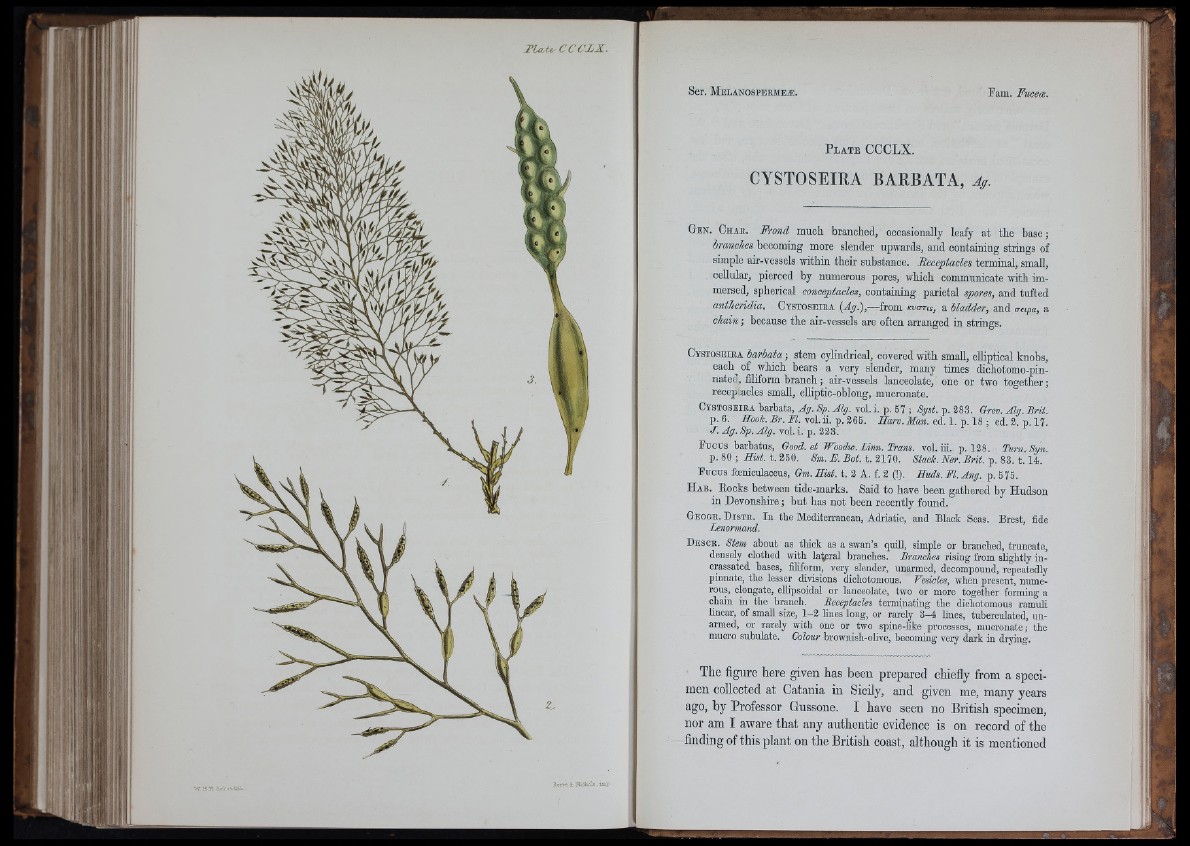
m
dj;
11
l 4:
faV H H i i l eflitK .
P l a t e CCCLX.
CYSTOSEIRA BARBATA, Ag.
G e n . C h a r . Frond much branched, occasionally leafy at the base ;
branches becoming more slender upwards, and containing strings of
simple air-vessels within their substance. Receptacles terminal, small,
cellular, pierced by numerous pores, which communicate with immersed,
spherical conceptacles, containing parietal spores, and tufted
C y s to s e i r a [Ag.],—from kvctk, a bladder, and o-tipa, a
because the air-vessels are often arranged in strings.
Cyst--o--s-e--ir--a-------------; stem cylindrical, covered with smaU, eUiptical knobs,
each^ of which bears a very slender, many times dichotomo-pin-
natec, filiform branch; air-vessels lanceolate, one or two together;
reoep acles small, elliptic-oblong, mucronate.
Cystoseira barbata, Ag. Sp. Alg. vol. i. p. 57 ; Syst. p. 283. Grev. Alg. Brit.
p. 6. Hook. Br. FI. vol. ii. p. 265. Harv. Man. ed. 1. p. 18 ; ed. 2. p. 17.
J. Ag. Sp. Alg. vol. i. p. 223.
Fuous barbatus, Good, et Woodw. Linn. Trans, vol. iii. p. 128. Turn. Syn.
p. 80 ; Hist. t. 250. Sm. E. Bot. t. 2170. Stack. Ner. Brit. p. 83. t. 14.
F ucu s foeuiculaceus, Gm. H ist. t. 2 A. f. 2 (!). Huds. FI. Ang. p. 575.
H a b . Eocks between tide-marks. Said to have been gathered by Hudson
in Devonshire ; but has not been recently found.
Geogr. Dis t r . In the Mediterranean, Adriatic, and Black Seas. Brest, fide
D e sc e . Stem about as thick as a swan’s quiU, simple or branched, truncate,
densely clothed with lateral branches. Branches rising from slightly incrassated
bases, filiform, very slender, unarmed, decompound, repeatedly
pinnate, the lesser divisions dichotomous. Vesicles, when present, numerous,
elongate, ellipsoidal or lanceolate, two or more together forming a
chain in the branch. Receptacles terminating the dichotomous ramuli
linear, of small size, 1 -2 lines long, or rarely 3 -4 lines, tuberculated, unarmed,
or rarely with one or two spine-like processes, mucronate; the
mucro subulate. Colour brownish-oHve, becoming very dark in drying.
The figure here given has been prepared chiefly from a specimen
collected at Catania in Sicily, and given me, many years
ago, by Professor Gussone. I have seen no British specimen,
nor am I aware that any authentic evidence is on record of the
finding of this plant on the British coast, although it is mentioned